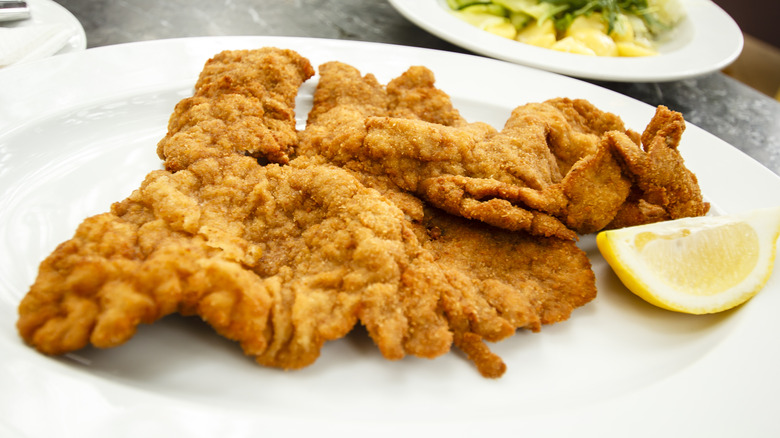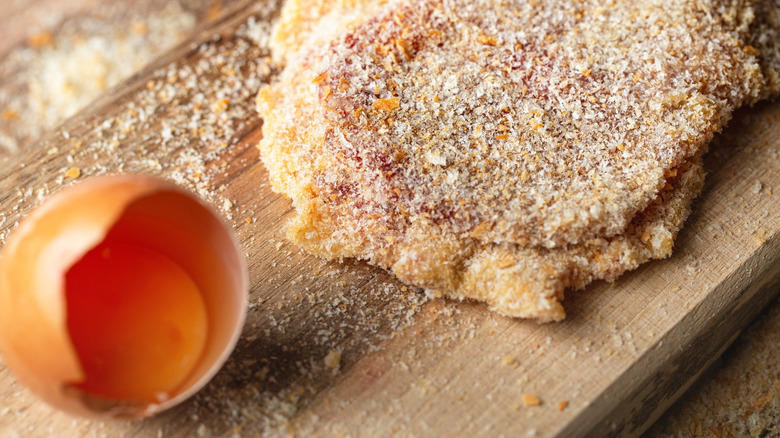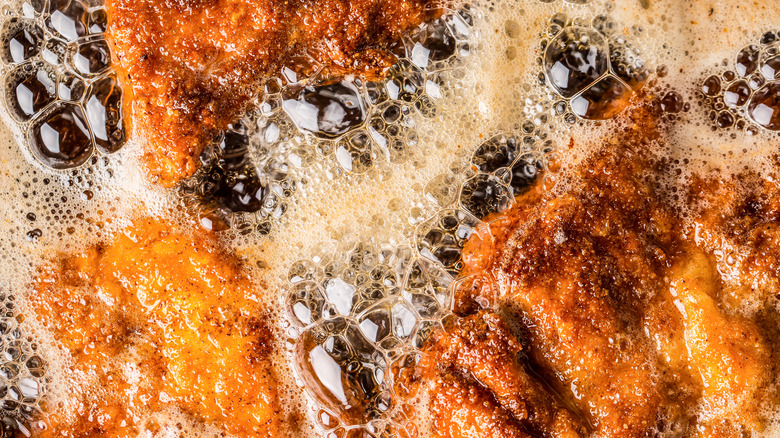Wiener Schnitzel's Ingredients Are Actually Defined By Law
In some parts of the United States, the name Wienerschnitzel has come to be associated with the hot dog-peddling fast food chain, which is rather odd considering the restaurant doesn't actually serve the dish after which it is named (via Mercury News). This fact must surely have untold scores of Austrian souls spinning in their graves, as wiener schnitzel is a legitimate national treasure to them. In fact, the dish is named after Vienna, as National Geographic points out that the Wien- prefix is used to denote the Austrian capital city.
A proper Wiener schnitzel is made from a veal cutlet, which is pounded to uniform thinness before being dredged in flour, egg wash, and breadcrumbs, in that order. It is then fried in hot oil or butter, and when you combine breaded meat with boiling butter, you know you've got a winning combination. Similar dishes are made using chicken and pork, but the German Food Guide is very clear that you can only call it Wiener schnitzel if it is made from veal. That's not a matter of opinion or regional preference; it's actually the law.
The origin of Wiener schnitzel
The Viennese, and Austrians in general, hold Wiener schnitzel close to their hearts, but the actual origin of this dish has been the subject of some debate. National Geographic repeats the most common theory, which says that the Austrians were inspired by an Italian dish called costoletta alla Milanese. Like Wiener schnitzel, costoletta alla Milanese was made by pounding, breading, and frying veal cutlets. It is said that the dish was introduced to Vienna in 1857 by Field Marshal Joseph Radetzky, who discovered it in the Italian territories that Austria took over under the Habsburg dynasty.
However, this oft-repeated origin story has been contested. National Geographic notes that Radetzky wrote to the Austrian emperor about a deliciously breaded veal cutlet he encountered in Italy, but it's unlikely that this was the first time Austrians had encountered such a dish. BBC Travel reveals that recipes for breaded cutlets appear in Austrian cookbooks a century before Radetzky's letter to the emperor. By 1831, the name Wiener schnitzel was already in use. The dish gained popularity because, as Werner Sedlacek, director of the Culinary Institute of Vienna told the BBC, it served as a clever way to repurpose stale bread. Plus, fried food tends to be a big hit no matter where you go.
Protecting Wiener schnitzel
Wiener schnitzel as a name is legally protected in both Austria and Germany. Per BBC Travel, there are different kinds of schnitzel made from different kinds of meat, but you can only call it Wiener schnitzel if it's made from veal. Escape explains that the nation of Austria has trademarked the term, and any restaurant in the country that serves breaded cutlets made from another kind of meat needs to add a disclaimer to the name. How that disclaimer works is very simple: Instead of just saying Wiener schnitzel, you must say "Wiener schnitzel vom" which means "Viennese schnitzel with," followed by the meat you are using.
Popular alternatives to veal include Wiener schnitzel vom huhn (with chicken), Wiener schnitzel vom schwein (with pork), and Wiener schnitzel vom pute (with turkey). Germany has similar rules that reserve the name Wiener schnitzel for veal cutlets. According to the German Food Guide, pork schnitzel is called schweine-schnitzel, turkey schnitzel is called puten-schnitzel, and chicken schnitzel is known as hänchen-schnitzel. No matter what meat is used, schnitzel is typically served plain with only a slice of lemon to be squeezed over the top. However, many regional variants exist, with one of the most popular being jäger-schnitzel, a cutlet topped with mushroom gravy that sometimes forgoes the breading process entirely.


